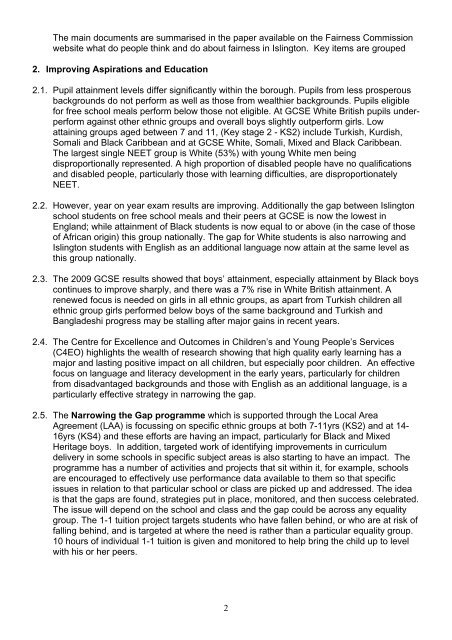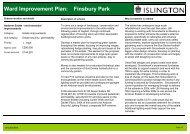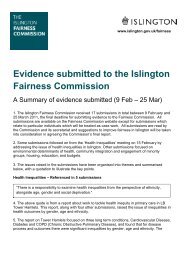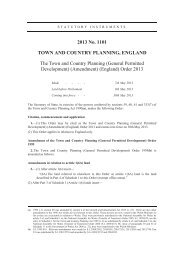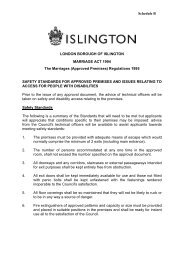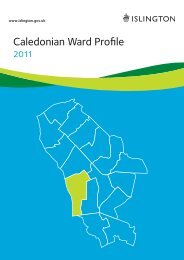Two Islingtons: Understanding the Problem - Islington Council
Two Islingtons: Understanding the Problem - Islington Council
Two Islingtons: Understanding the Problem - Islington Council
Create successful ePaper yourself
Turn your PDF publications into a flip-book with our unique Google optimized e-Paper software.
The main documents are summarised in <strong>the</strong> paper available on <strong>the</strong> Fairness Commission<br />
website what do people think and do about fairness in <strong>Islington</strong>. Key items are grouped<br />
2. Improving Aspirations and Education<br />
2.1. Pupil attainment levels differ significantly within <strong>the</strong> borough. Pupils from less prosperous<br />
backgrounds do not perform as well as those from wealthier backgrounds. Pupils eligible<br />
for free school meals perform below those not eligible. At GCSE White British pupils underperform<br />
against o<strong>the</strong>r ethnic groups and overall boys slightly outperform girls. Low<br />
attaining groups aged between 7 and 11, (Key stage 2 - KS2) include Turkish, Kurdish,<br />
Somali and Black Caribbean and at GCSE White, Somali, Mixed and Black Caribbean.<br />
The largest single NEET group is White (53%) with young White men being<br />
disproportionally represented. A high proportion of disabled people have no qualifications<br />
and disabled people, particularly those with learning difficulties, are disproportionately<br />
NEET.<br />
2.2. However, year on year exam results are improving. Additionally <strong>the</strong> gap between <strong>Islington</strong><br />
school students on free school meals and <strong>the</strong>ir peers at GCSE is now <strong>the</strong> lowest in<br />
England; while attainment of Black students is now equal to or above (in <strong>the</strong> case of those<br />
of African origin) this group nationally. The gap for White students is also narrowing and<br />
<strong>Islington</strong> students with English as an additional language now attain at <strong>the</strong> same level as<br />
this group nationally.<br />
2.3. The 2009 GCSE results showed that boys’ attainment, especially attainment by Black boys<br />
continues to improve sharply, and <strong>the</strong>re was a 7% rise in White British attainment. A<br />
renewed focus is needed on girls in all ethnic groups, as apart from Turkish children all<br />
ethnic group girls performed below boys of <strong>the</strong> same background and Turkish and<br />
Bangladeshi progress may be stalling after major gains in recent years.<br />
2.4. The Centre for Excellence and Outcomes in Children’s and Young People’s Services<br />
(C4EO) highlights <strong>the</strong> wealth of research showing that high quality early learning has a<br />
major and lasting positive impact on all children, but especially poor children. An effective<br />
focus on language and literacy development in <strong>the</strong> early years, particularly for children<br />
from disadvantaged backgrounds and those with English as an additional language, is a<br />
particularly effective strategy in narrowing <strong>the</strong> gap.<br />
2.5. The Narrowing <strong>the</strong> Gap programme which is supported through <strong>the</strong> Local Area<br />
Agreement (LAA) is focussing on specific ethnic groups at both 7-11yrs (KS2) and at 14-<br />
16yrs (KS4) and <strong>the</strong>se efforts are having an impact, particularly for Black and Mixed<br />
Heritage boys. In addition, targeted work of identifying improvements in curriculum<br />
delivery in some schools in specific subject areas is also starting to have an impact. The<br />
programme has a number of activities and projects that sit within it, for example, schools<br />
are encouraged to effectively use performance data available to <strong>the</strong>m so that specific<br />
issues in relation to that particular school or class are picked up and addressed. The idea<br />
is that <strong>the</strong> gaps are found, strategies put in place, monitored, and <strong>the</strong>n success celebrated.<br />
The issue will depend on <strong>the</strong> school and class and <strong>the</strong> gap could be across any equality<br />
group. The 1-1 tuition project targets students who have fallen behind, or who are at risk of<br />
falling behind, and is targeted at where <strong>the</strong> need is ra<strong>the</strong>r than a particular equality group.<br />
10 hours of individual 1-1 tuition is given and monitored to help bring <strong>the</strong> child up to level<br />
with his or her peers.<br />
2


